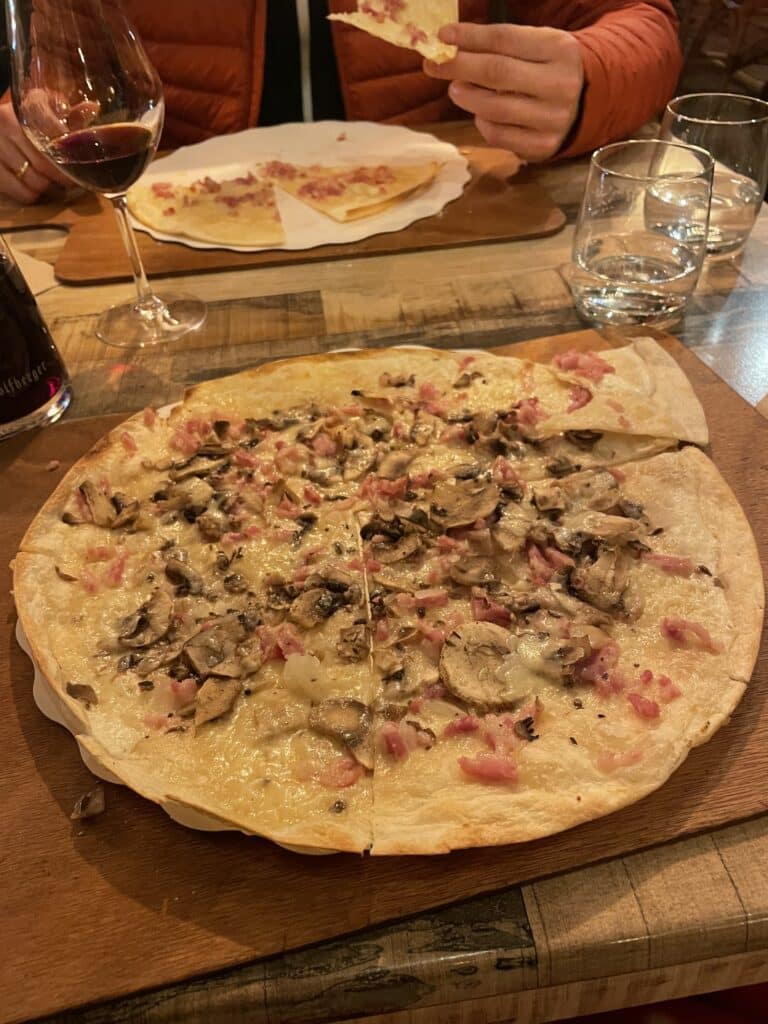As I drove towards Alsace from the east, the view unfolding before me was exactly as the wine guidebooks described this French region. A sea of clouds nestled peacefully atop the Vosges mountains, creating a captivating horizon. Interestingly, Alsace is known as the driest part of France. Despite its northern location, the surrounding mountains bless Alsace with the most sunny days in the country, making it an ideal grape-growing region. Local vignerons (French for winemakers) certainly make the most of this advantage.
Crossing the German-French border around sundown, I was eager to delve into the complexities of this small yet intricate wine region. However, recalling my experience in Tuscany, I decided to start my exploration the next afternoon, as morning wine tastings are seldom a good idea. After a delightful lunch in our base town of Colmar, I discovered that Alsace was indeed everything the books and guides promised. Vineyards blanket every nook and cranny of the countryside, with large sections classified as Grand Cru – a designation for the highest quality of soil and environmental factors. The rolling hills, adorned with quaint mediaeval villages and towns, offered a picturesque, fairytale-like setting. The autumn palette of greens, yellows, and browns was simply breathtaking.

I had always regarded Tuscany as particularly notable for its abundance of vineyards and winemakers, but their sheer volume in the heart of Alsace was astounding. Along the Route des Vins d’Alsace (Alsace Wine Route), a winery appears nearly every hundred yards. This holds true for the towns as well. In Riquewihr, for instance, I discovered wineries in every other building, most offering casual, complimentary tastings. The maths was staggering: considering the average winery offers around 20 different bottles, the tasting possibilities seemed endless. I could easily spend a year here and only scratch the surface of this iceberg of wine.
But why so many different wines? This can be traced back to a specific winemaking philosophy ardently practised in Alsace. Here, a winemaker’s primary role is to subtly and naturally showcase the interplay between a grape variety and terroir.As a result, a single winery might produce several Rieslings, each from a different part of their estate. Local vignerons believe there are over 800 unique terroirs in Alsace, each significantly influencing the wine’s final character. Naturally, the most coveted plots are those within the Grand Cru vineyards.
Alsace is renowned for its white wines, which constitute 90% of its production. The main varieties include Riesling, Pinot Blanc, Gewürztraminer, and Pinot Gris, with Pinot Noir leading the red wine production. Striving for naturalness and a true reflection of the terroir, Alsacian winemakers minimise their intervention within the winery. This includes using wild yeast for fermentation and predominantly ageing wine in stainless steel tanks to avoid flavour alteration from wood. The wines, especially when young, are characterised by their pronounced acidity, lending themselves well to ageing – a trait more typical of red wines. Alsacian whites are usually very dry, pairing beautifully with the region’s German-influenced cuisine. However, producers have recently been experimenting with sugar content, particularly in Gewürztraminer and Pinot Blanc-based wines.



During my afternoon adventure, I visited three wine producers: Fritsch & Fils, Hugel, and Horcher. I chose a mix of small, family-run vineyards and the more renowned Hugel. Each tasting session provided a rich array of wines, with the Riesling category alone offering 3-6 different selections.
At Fritsch & Fils, who are on the smaller end of the spectrum, I tried their Pinot Gris, Pinot Blanc, and Gewürztraminer. The wines were a good representation of different grape varieties, though I initially found the high sugar content overpowering. These wines were approachable, but somewhat lacking in complexity. However, their affordability, with the most expensive bottle at just 10 €, was a plus.
At Hugel, a leading winery in both scale and recognition, I embarked on a deep Riesling exploration. Despite being a large-scale family business, Hugel has maintained its quality, exporting over a million bottles annually to more than a hundred countries. Their Riesling collection ranges from 17.20 € to 175 € per bottle.
Riesling Estate 2019 had a sweet aroma of honey and fresh flowers. It was a very dry wine. I could taste some further honey and pepper flavours. The wine was elegant, complex and with a long finish. Acidity was less pronounced than in a typical Riesling. The next one, Riesling Grand Cru 2014, reminded me more of a “classic” Riesling. Lemon, lime and green apple notes dominated. In this bottle, the crisp acidity played a major role creating a powerful and full-bodied wine. While the higher-priced wines were exquisite, I pondered whether their nuances justified the cost for the average wine enthusiast.

Horcher, a bit off the beaten path, offered an intriguing contrast with its two Pinot Noirs and two Crémant d’Alsace (local sparkling wines). The Tradition Pinot Noir was simpler and fruitier, while the Selection was richer and more nuanced. Their affordability made them great everyday reds. The Crémant d’Alsace and Rosé were spendid, buttery, and fruity, providing an excellent alternative to more expensive champagnes.

My days in Alsace were a magical immersion in a region that felt like a place plucked from a fairytale. The charming towns, delicious local fare, and, most importantly, the superb wines made it a memorable journey. Lost among the hills, I could only begin to fathom the hundreds of micro-terroirs that define this unique winemaking landscape…



Fritsch & Fils winery: https://www.vins-fritsch.com/.
Hugel winery: https://m.hugel.com/598DGMB3C4?l=en.
Horcher winery: https://vin-horcher.com/#.

Więcej nieWinnych Podróży wprost na Twoją skrzynkę? Zapisz się!

